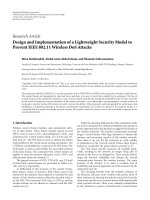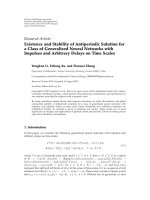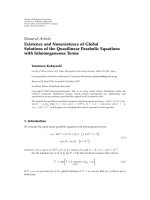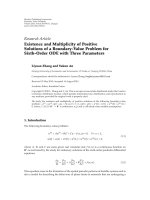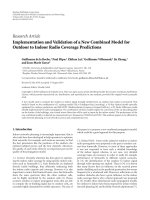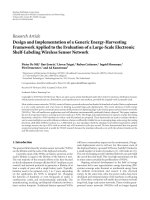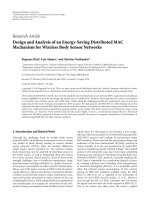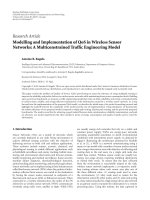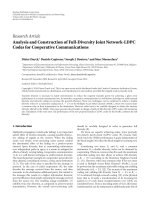Báo cáo hóa học: " Research Article Development and Evaluation of High-Performance Decorrelation Algorithms for the Nonalternating 3D Wavelet Transform" pdf
Bạn đang xem bản rút gọn của tài liệu. Xem và tải ngay bản đầy đủ của tài liệu tại đây (1.54 MB, 11 trang )
Hindawi Publishing Corporation
EURASIP Journal on Advances in Signal Processing
Volume 2007, Article ID 69384, 11 pages
doi:10.1155/2007/69384
Research Article
Development and Evaluation of High-Performance
Decorrelation Algorithms for the Nonalternating 3D
Wavelet Transform
E. Moyano-
´
Avila,
1
F. J. Quiles,
2
and L. Orozco-Barbosa
2
1
Depar t amento de Tecnolog
´
ıas y Sistemas de Informaci
`
on, Universidad de Castilla-La Mancha, 45071 Toledo, Spain
2
Departamento de Sistemas Tecnolog
´
ıas, Universidad de Castilla-La Mancha, 02071 Albacete, Spain
Received 2 September 2006; Revised 30 December 2006; Accepted 27 March 2007
Recommended by Erwin De Kock
We introduce and evaluate the implementations of three parallel video-sequences decorrelation algorithms. The proposed algo-
rithms are based on the nonalternating classic three-dimensional wavelet transform (3D-WT). The parallel implementations of
the algorithms are developed and tested on a shared memory system, an SGI origin 3800 supercomputer making use of a message-
passing paradigm. We evaluate and analyze the performance of the implementations in terms of the response time and speed-up
factor by varying the number of processors and various video coding parameters. The key points enabling the development of
highly efficient implementations rely on the partitioning of the video sequences into groups of frames and a workload distribu-
tion strategy supplemented by the use of parallel I/O primitives, for better exploiting the inherent features of the application and
computing platform. We also evaluate the effectiveness of our algorithms in terms of the first-order entropy.
Copyright © 2007 E. Moyano-
´
Avila et al. This is an open access article dist ributed under the Creative Commons Attribution
License, which permits unrestricted use, distribution, and reproduction in any medium, provided the original work is properly
cited.
1. INTRODUCTION
In recent years, the rapid growth in the field of medical imag-
ing has enabled the development of several new classes of
digital images, videos, or image sequences. Visual data ap-
plications are characterized by their stringent requirements
in terms of storage, processing, and transmission. The use
of video compression techniques can significantly reduce the
storage and communications requirements of video applica-
tions. However, the compression of visual data is a compu-
tationally intensive. In this context, the use of parallel high-
performance computer architectures can prove to be an ef-
fective solution particularly when large volumes of visual
data have to be processed [1, 2].
In this paper, we evaluate the parallel implementations of
three image-sequences decorrelation algor ithms having been
recently introduced in one of our previous works [3]. The
algorithms had been developed around the nonalternating
classic wavelet-based transform algorithms versus the Clas-
sic method [4]. The development of these novel algorithms
has b een motivated by the need of coping with the stringent
requirements of visual data: huge storage and high process-
ing demands [3]. Due to the inherent characteristics of the
video s equences of our interests, that is, angiograms, we have
partitioned the video sequences into group of frames. This
partitioning scheme has proven to be highly effective in re-
ducing the memory resources required for evaluating the 3D-
WT [5].
We experimentally evaluate the performance of our pro-
posals in a shared-memory multiprocessor system mak-
ing use of a message-passing programming paradigm, built
around the standard message passing interface: MPI and its
associated MPI-IO subsystem [6, 7]. In order to further im-
prove the performance of the actual implementation, we
have paid particular attention to the workload distribution
allowing us to reduce the communication steps and number
of I/O operations: two key issues when dealing with applica-
tions requiring the sharing and exchange of large volumes of
data distributed among the multiple elements of a multipro-
cessor platform.
In the following, the paper is organized as follows.
Section 2 reviews the principles of the 3D-WT. We briefly
overview the fragmentation scheme and the principles of the
classic and nonalternating classic 3D-WT: two relevant ele-
ments used in the design of our high-performance video de-
correlation algorithms. Section 3 overviews the related work,
2 EURASIP Journal on Advances in Sig nal Processing
both in the areas of video processing and parallel process-
ing of video sequences. Section 4 reviews the operation of
our algorithms. Section 5 describes the parall el implementa-
tion of the decorrelation algorithms with particular empha-
sis on the workload distribution scheme employed. Section 6
reports the experimental results in terms of the processing
time, speed-up, and quality of the signal achieved by making
use of a parallel multiprocessor system. Finally, our conclu-
sions are given in Section 7 .
2. 3D WAVELET TRANSFORM
Over the past few years, there have been numerous reports
on the use of wavelets in many fields. wavelet-based meth-
ods are well suited for a variety of data processing tasks, and
especially for image and video compression [1, 5].
2.1. Wavelet analysis and the 3D wavelet transform
Wavelet analysis procedures involve the decomposition of a
signal into scaled and shifted signals. In this way, the WT
analyzes a signal at different frequency bands with different
resolutions by decomposing it into a coarse approximation
and detail information. An efficient way of implementing a
discrete wavelet transform is possible by using filter banks.
This scheme has b een developed by Mallat [8]. The multires-
olution decomposition of the signal into different frequency
bands is obtained by successive highpass and lowpass filter-
ing. The lowest resolution band includes the high-magnitude
approximation coefficients of the signal. Most of the energy
is captured by those coefficients while most of the detail co-
efficients have small or even null magnitudes. After filter-
ing, the signal can be subsampled by two. This is called one
level of decomposition. Every decomposition level halves the
spatial/time resolution since only half the number of sam-
ples characterizes the complete signal. However, this opera-
tion doubles the frequency resolution. This procedure is also
known as subband coding and can be successively repeated
for further decomposition.
2.2. The nonalternating versus alternating
classic 3D-WT
The 3D-WT can be performed by applying three separate
1D-WT along the three dimensions of a video sequence:
the time dimension, the horizontal (rows), and the verti-
cal (columns) dimensions of each frame. The temporal one-
dimensional unitary filter is applied to the same pixel in ev-
ery frame of the sequence [9]. The process of applying the
3D-WT to all the three dimensions defines a decomposition
level. Thereafter, the same procedure can be applied to the
resulting coarse scale approximation to further decompose
the sequence. This procedure is carried out as many times as
levels have been predefined.
The 3D-WT of a video sequence can be constructed us-
ing the 1D wavelet transform in two ways: the classic de-
composition and the nonalternating classic decomposition.
Figure 1 shows the classic (Figure 1(a)) and the nonalternat-
ing classic Figure 1(b) 3D-WT decomposition schemes [4].
x
y
t
(a)
x
y
t
(b)
Figure 1: (a) Classic and (b) nonalternating classic 3D wavelet de-
composition schemes.
The black cube in both schemes depicts the lowest frequen-
cies in a group of consecutive frames, in the time domain,
and the remaining cubes or bands show the details at 3D
wavelet decomposition.
The classic decomposition is computed by applying the
1D-WT transform alternating between frames, rows and
columns of the video sequence for each decomposition level
(see Figure 1(a)). This way to compute the classic 3D-WT is
not efficient overall since it imposes stringent requirement
on the memory requirements. That is to say, all the frames
in the sequence should be readily available to perform the
temporal wavelet transform. In general, this is unfeasible to
do when the amount of frames in a video sequence is large.
Even if this requirement is lifted by temporally fragmenting
the video sequence (see Section 2.3), the fact of alternating
from the time to the horizontal and the vertical domains and
back makes it unsuitable for a straightforward and efficient
parallelization. In this case, the data to be processed at each
change w ill have to be redistributed at the beginning of each
level and change of domain, that is, from frames to rows,
from rows to columns, from columns to frames, and so on.
The nonalternating classic algorithm is a different way
to perform the wavelet transform, whose main feature is
to carry out all decomposition levels over a data dimen-
sion before applying them on to the next data dimension
(see Figure 1(b)). This means that the WT is applied by di-
mension but not by levels. That is to say, the nonalternating
E. Moyano-
´
Avila et al. 3
classic method of the 2D-WT involves the data transforma-
tion on the row domain at all levels before proceeding with
the data decomposition on the column domain.
The nonalternating classic WT takes advantage of hav-
ing a particular dimension data in memory to perform all
the decomposition levels. This avoids changing the context
alternatively on each decomposition level. The disadvantage
is the higher number of samples to process at each level (ex-
cept the first level) because of the higher size of low frequency
bands. However, we will show that the use of a proper work-
load mechanism may significantly contribute to improve the
overall performance of the nonalternating classic algorithm,
in terms of the processing time, speed-up, and the quality of
the signal.
2.3. GOF-based 3D-WT
One of the major challenges to overcome when computing
the 3D-WT has to do with the development of efficient al-
gorithms capable of handling video sequences composed of
a large number of video frames. In particular, computing
the temporal WT requires the simultaneous access to all the
frames in the sequence. In general, this is unfeasible when
dealing with v ideo sequences composed of a large number
of images. Yet, the use of large virtual memory space may
not provide a satisfactory solution due to the overhead in-
troduced by the paging mechanisms used to make all the
required information available to the processor. This prob-
lem can be solved by fragmenting the sequence into indepen-
dent units for its temporal decomposition: group of frames
(GOF).
The GOF-based 3D-WT overcomes the huge memory
requirements required for processing the whole sequence.
This grouping technique has proven to be particularly use-
ful for the processing of video sequences characterized by
low motion, that is, having few differences among consecu-
tive frames [5]. This is particularly tr ue in medical sequences,
such as angiograms. In these cases, the grouping of a larger
number of frames in a GOF allows to capture most temporal
redundancies a nd increase the coding efficiency.
After carrying out the temporal decomposition over a
GOF, a 2D wavelet transform can be applied to the relevant
frames in the group, according to the decomposition level.
This latter task is only performed to the temporal low fre-
quency bands. All the decomposition levels must be applied
to the current GOF. This process finishes when all GOFs in
the original sequence are transformed by the predetermined
number of levels.
3. RELATED WORK
In the past few years, there has been an increasing inter-
est on the parallel computation of various signal processing
transforms, such as the FFT, DCT, and wavelet transforms.
Some efforts have focused on special architectures for the fast
computation of some of these transforms. For instance, in
[10] Modarressi and Sarbazi-Azad have proposed an algo-
rithm for the calculation of the 3D DCT over a k-ary n-cube
architecture enabling its computation on real time. However
they do not present a numerical evaluation of the proposed
scheme. The y have also overlooked the I/O processing, an
important issue when dealing with huge volumes of data. In
fact, many studies have focused on reducing the impact of the
I/O methods being used over the performance of parallel al-
gorithms involving the processing of large data sets. Towards
this end, Yu and Ma have studied various I/O methods to be
integrated into a parallel visualization system [11]. They have
focused their study on the MPI-IO parallel technology. They
have found out that special attention has to be paid to the I/O
system by dedicating special resources and by properly tun-
ing the I/O mechanisms, such as a dedicated input processor
and adaptive fetching mechanisms. Another relevant work
on the design of parallel algorithms has been carried out by
Wapperom et al. [12]. They have designed and evaluated a
parallel algorithm for computing the three-dimensional FFT.
They have also found out that the I/O mechanisms play a
central role on the performance of the overall parallel sys-
tems. T hey have based their system on MPI using two differ-
ent platforms: an origin2000 and an alphaserver cluster hav-
ing paid particular attention to the impact of the I/O meth-
ods over the overall performance of the parallel processing
algorithm.
Various relevant research efforts have been reported
lately for the wavelet transform. Thulasiraman et al. have de-
veloped a multithreaded algorithm for computing the 2D
wavelet transform [13]. The authors conduct a set of ex-
perimental trails over an emulated multithreaded platform
and came to the conclusion that their system outperforms
the MPI-based implementations having been reported in the
literature. Even though their results are very promising, the
unavailability of a complete (hardware/software) fine coarse
system leaves open the debate on the overall performance
gains of such systems.
Regarding the 3D wavelet transform, Kutil and Uhl have
conducted a study of the software and hardware needs of the
3D wavelet transform [14]. They have centered their study on
the classic wavelet transform and conducted a set of trials on
an SGI PowerChallenge. They have not, however, considered
the use of the GOF concept in order to minimize the memory
requirements when computing the 3D-WT. In a recent study
they have focused on the time taken by the wavelet transform
decomposition making part of the JPEG 2000 and MPEG-4
VTC image compression standards [15]. They have used a
shared memory programming paradigm based on OpenMP.
Once again, they only considered the classic 2D-WT.
In a recent paper [16], Katona et al. have studied the use
offield-programmablegatearraysasameanstoimplement
a real-time wavelet-domain video denoising algorithm. The
proposed architecture makes use of two FPGAs. While the
first one is dedicated to performing the wavelet decomposi-
tion, the second one reads the wavelet coefficients. The re-
ported results show the effectiveness of the proposed scheme
for real-time video processing. Even though the results are
encouraging, the experimental platform is still under devel-
opment as the noise level estimation requires the user inter-
vention.
4 EURASIP Journal on Advances in Sig nal Processing
A
BCD
L
PF
H
PF
[n × (N × N), 1]
[n
× (N × N), 1]
LL HH
Tem p or al
domain
level 1
L
PF
H
PF
[n/2 × (N × N), 2] [n/2 × (N × N), 2]
Tem p or al
domain
level 2
LHLL
Figure 2: NoAl-classic algorithm: temporal decomposition.
Even though there have been many studies conducted on
the parallel computation of various signal processing trans-
forms, no in-depth studies have been reported on parallel
algorithms to perform the spatial and temporal decompo-
sitions. Furthermore, they have not fully examined the use of
workload strategies as a means to overcome the overhead of
moving huge amounts of visual data. In this paper, we ad-
dress these two issues, that is, alternative ways for comput-
ing the spatial and temporal decompositions and the use of
workload strategies supplemented by state-of-the art parallel
I/O mechanisms. Our algorithms aim at reducing the num-
ber of communication operations required to exchange data
among the participating processors. We evaluate the overall
performance of our proposals in an SGI origin 3800 making
use of message passing paradigm based on MPI including the
use of the MPI-IO library. The overall system performance is
measured in terms of the response time and speed-up fac-
tor. We also evaluate the quality of the signal in terms of the
first-order entropy.
4. NONALTERNATING WT ALGORITHMS
In this section, we describe the three algorithms whose paral-
lel implementations and evaluation make the subject of this
paper. All three algorithms are based on the nonalternating
classicWT.Inordertoeffectively reduce the huge memory
requirements when applying the 1D-WT over the temporal
domain, we propose the use of the GOF-based scheme intro-
duced in Section 2.3.
According to the principles of operation of the nonal-
ternating classic scheme, the 1D-WT is applied over a di-
mension as many times as having been predefined, before
proceeding with the decomposition on the other dimension.
That is to say, instead of alternatively transforming the tem-
poral, horizontal (rows), and vertical (columns) domains,
the algorithms presented herein completely apply the 1D-
WT over a domain as many times as levels have been pre-
defined. The following three figures show the details of the
nonalternating classic algorithm.
Figure 2 explicitly depicts the case of a two-level temporal
decomposition over a GOF consisting of four frames, named
A
BC
D
L
PF
H
PF
[n × (N × N), 3]
[n
× (N × N), 3]
LLLL HHHH
Spatial
domain
(rows)
level 1
L
PF
H
PF
[n/2 × (N × N/2), 4] [n/2 × (N × N/2), 4]
LHLL LL LH
Spatial
domain
(rows)
level 2
Figure 3: NoAl-classic algorithm: horizontal spatial decomposition
(rows).
A
BCD
L
PF
H
PF
[n × (N × N), 5]
[n
× (N × N), 5]
L
L
L
L
H
H
H
H
Spatial
domain
(columns)
level 1
L
PF
H
PF
[n/2 × (N/ 2 × N ), 6]
[n/2
× (N/2 × N), 6]
LH
LL
LL
LH
Spatial
domain
(columns)
level 2
Figure 4: NoAl-classic algorithm: vertical spatial decomposition
(columns).
A, B, C, and D. As shown in the figure, the first decompo-
sition is carried out over all the four frames resulting in two
blocks containing the low-frequency bands labeled L and two
blocks containing the high-frequency bands, labeled in turn
H. Each one of these blocks is equivalent in size to an original
frame. Figure 2 also shows that a second level of decomposi-
tion on the temporal domain is applied to the low-frequency
bands which produces a block with the subband LL and a
second one with the LH subband. In this figure, as well as in
Figures 3 and 4, the notation [n
× (N × N), l] indicates the
main features of the data being manipulated, that is to say, n
indicates the number of frames per GOF. For instance, in the
case of the decomposition carried out at level 2, this number
will be halved in every dimension, indicating the number of
frames in the GOF to be processed. N
×N gives the size of the
frames in pixels while the third parameter indicates the step
number for the different levels of decomposition for the 3D-
WT. For the sake of clarity, in the figures, we only represent
two levels over e ach data dimension.
Figure 3 shows the two-level spatial (horizontal) decom-
position. The output of this first level decomposition results
E. Moyano-
´
Avila et al. 5
in four blocks containing the lowpass bands (two of them
pertaining to the temporal low-frequency bands and the
other two pertaining to the temporal high bands) and four
other blocks containing the highpass bands. According to the
classic algorithm, in the second level, only the low-pass band
is processed for its further decomposition. As seen from the
figure, the second level decomposition results in four blocks,
containing the LL, LL, LH, and LH subbands. It is worth to
notice that at each level of decomposition the amount of data
to be processed is reduced. Fur thermore, according to the
classic algorithm, only the lowpass band is further processed
at each level of decomposition.
In a similar way to the horizontal decomposition, the ver-
tical decomposition is carried out over a GOF. As a result of
the first level of decomposition, four blocks containing the
L bands and four other blocks containing the H bands are
obtained (see Figure 4). In the second le vel, and according to
the classic algorithm, the decomposition is carried out only
over the L bands, resulting in four blocks containing the LL
and LH subbands.
The other two algorithms to be introduced aim to fur-
ther eliminate time and space redundancies for a more effi-
cient encoding of the resulting wavelet coefficients. The clas-
sic 3D-WT algorithm does not effectively reduce the spa-
tial redundancies on every video frame. The reason is that
it only applies all spatial decomposition levels over frames
pertaining to the temporal low-frequency bands. As we will
show, the removal of spatial redundancies from the temporal
high-frequency bands implies a light increase on the compu-
tational complexity of the encoding process, but it will cer-
tainly result in a better coding efficiency.
The first of the algorithms, namely the NoAl-N0 algo-
rithm, applies only one temporal decomposition level on a
GOF. Furthermore, this algorithm only aims to reduce most
spatial redundancies at every frame in a GOF, since it ap-
plies all the spatial decomposition levels over all the tem-
poral subbands (L and H) and not only on those pertain-
ing to the temporal low-frequency sub-bands; as done by the
NoAl-classic (only L subbands in Figure 2) and classic algo-
rithms.
The NoAl-N1 algorithm, similar to the NoAl-N0 algo-
rithm, attempts to eliminate all the spatial redundancies, but
it goes a step further by eliminating the temporal redun-
dancies present in the image sequence. Then, it carries out
the predetermined le vels of temporal and spatial decomposi-
tions, but the spatial transform is applied over all the tempo-
ral sub-bands, as done by the NoAl-N0 algorithm.
The NoAl-classic, NoAl-N0, and NoAl-N1 algorithms re-
quire keeping in memory all the frames in a GOF to perform
the temporal decomposition. In a sequential implementa-
tion, all the frames of a GOF have to be readily available
to perform the temporal decomposition. This means that all
frames in a GOF have to be in memory despite memory de-
mands and cache misses. The latter can heavily impact the
performance of the overall process. The problem is aggra-
vated if a GOF consists of a large number of frames and large
frame sizes. We then propose the use of parallel processing as
an effective way to carry out the 3D-WT decomposition.
ABCD
a
1
a
2
a
3
a
4
a
5
a
6
a
7
a
8
a
9
a
10
a
11
a
12
a
13
a
14
a
15
a
16
b
1
b
2
b
3
b
4
b
5
b
6
b
7
b
8
b
9
b
10
b
11
b
12
b
13
b
14
b
15
b
16
c
1
c
2
c
3
c
4
c
5
c
6
c
7
c
8
c
9
c
10
c
11
c
12
c
13
c
14
c
15
c
16
d
1
d
2
d
3
d
4
d
5
d
6
d
7
d
8
d
9
d
10
d
11
d
12
d
13
d
14
d
15
d
16
Figure 5: A GOF consisting of four frames.
P1 P2 P3 P4
a
1
a
2
a
3
a
4
b
1
b
2
b
3
b
4
c
1
c
2
c
3
c
4
d
1
d
2
d
3
d
4
a
5
a
6
a
7
a
8
b
5
b
6
b
7
b
8
c
5
c
6
c
7
c
8
d
5
d
6
d
7
d
8
a
9
a
10
a
11
a
12
b
9
b
10
b
11
b
12
c
9
c
10
c
11
c
12
d
9
d
10
d
11
d
12
a
13
a
14
a
15
a
16
b
13
b
14
b
15
b
16
c
13
c
14
c
15
c
16
d
13
d
14
d
15
d
16
Figure 6: A distributed GOF (four frames) over four processors
(P1, P2, P3, P4).
5. PARALLELIZATION SCHEME
The key points of the parallelization scheme proposed herein
include a workload distribution strategy and the use of an
efficient parallel I/O subsystem exploiting the hardware fea-
tures.
5.1. Workload distribution strategy
The workload distribution strategy aims to evenly balance
the workload among the processors and reduce the num-
ber of cache misses. The strategy has been designed by tak-
ing into account both the application a nd the multiproces-
sor system features. Towards this end, we have made use of
the GOF-based scheme enabling the even distribution of the
video sequence among the participating processors. Figure 5
depicts the case of four frames per GOF, where each frame
has in turn been divided into four rows and each row into
four blocks. For instance, frame A has been divided into
four blocks per row, denoted from top to bottom by A
1
=
{
a
1
, a
2
, a
3
, a
4
},A
2
={a
5
, a
6
, a
7
, a
8
},A
3
={a
9
, a
10
, a
11
, a
12
},
and A
4
={a
13
, a
14
, a
15
, a
16
},whereeachrowhasbeensub-
divided into four blocks. Frames B to D have been frag-
mented in the same way. Furthermore, the frames are divided
into blocks of rows, X
i
,withi = 1, 2, , N,whereN denotes
the number of processors. The ith processor receives the ith
block of rows, within a GOF. Figure 6 illustrates the way the
four frames depicted in Figure 5 are distributed among four
processors, denoted by P1, P2, P3, and P4.
Under this workload distribution strategy, all frames in
a GOF are distr ibuted among N processors avoiding large
memory demands or cache misses over a single processor,
despite the GOF size. In this way, each active processor can
perform the temporal decomposition, the most critical task,
onaspecificblockofrowsofallframesinaGOF.Further-
more, every processor can perform the spatial decomposi-
tion on its complete rows and its blocks of rows of each
6 EURASIP Journal on Advances in Sig nal Processing
ABCD
a
1
a
2
a
3
a
4
a
5
a
6
a
7
a
8
a
9
a
10
a
11
a
12
a
13
a
14
a
15
a
16
b
1
b
2
b
3
b
4
b
5
b
6
b
7
b
8
b
9
b
10
b
11
b
12
b
13
b
14
b
15
b
16
c
1
c
2
c
3
c
4
c
5
c
6
c
7
c
8
c
9
c
10
c
11
c
12
c
13
c
14
c
15
c
16
d
1
d
2
d
3
d
4
d
5
d
6
d
7
d
8
d
9
d
10
d
11
d
12
d
13
d
14
d
15
d
16
I/O-1
I/O
P1 P2 P3 P4
a
1
a
2
a
3
a
4
b
1
b
2
b
3
b
4
c
1
c
2
c
3
c
4
d
1
d
2
d
3
d
4
a
5
a
6
a
7
a
8
b
5
b
6
b
7
b
8
c
5
c
6
c
7
c
8
d
5
d
6
d
7
d
8
a
9
a
10
a
11
a
12
b
9
b
10
b
11
b
12
c
9
c
10
c
11
c
12
d
9
d
10
d
11
d
12
a
13
a
14
a
15
a
16
b
13
b
14
b
15
b
16
c
13
c
14
c
15
c
16
d
13
d
14
d
15
d
16
P1 P2 P3 P4
a
1
a
2
a
3
a
4
b
1
b
2
b
3
b
4
c
1
c
2
c
3
c
4
d
1
d
2
d
3
d
4
a
5
a
6
a
7
a
8
b
5
b
6
b
7
b
8
c
5
c
6
c
7
c
8
d
5
d
6
d
7
d
8
a
9
a
10
a
11
a
12
b
9
b
10
b
11
b
12
c
9
c
10
c
11
c
12
d
9
d
10
d
11
d
12
a
13
a
14
a
15
a
16
b
13
b
14
b
15
b
16
c
13
c
14
c
15
c
16
d
13
d
14
d
15
d
16
C-1
P1 P2 P3 P4
a
1
a
2
a
3
a
4
b
1
b
2
b
3
b
4
c
1
c
2
c
3
c
4
d
1
d
2
d
3
d
4
a
5
a
6
a
7
a
8
b
5
b
6
b
7
b
8
c
5
c
6
c
7
c
8
d
5
d
6
d
7
d
8
a
9
a
10
a
11
a
12
b
9
b
10
b
11
b
12
c
9
c
10
c
11
c
12
d
9
d
10
d
11
d
12
a
13
a
14
a
15
a
16
b
13
b
14
b
15
b
16
c
13
c
14
c
15
c
16
d
13
d
14
d
15
d
16
C-1
ABCD
a
1
a
2
a
3
a
4
a
5
a
6
a
7
a
8
a
9
a
10
a
11
a
12
a
13
a
14
a
15
a
16
b
1
b
2
b
3
b
4
b
5
b
6
b
7
b
8
b
9
b
10
b
11
b
12
b
13
b
14
b
15
b
16
c
1
c
2
c
3
c
4
c
5
c
6
c
7
c
8
c
9
c
10
c
11
c
12
c
13
c
14
c
15
c
16
d
1
d
2
d
3
d
4
d
5
d
6
d
7
d
8
d
9
d
10
d
11
d
12
d
13
d
14
d
15
d
16
I/O-2
I/O
Figure 7: Parallel scheme: 4 frames per GOF and 4 processors (P: processor, C: communication, I/O: parallel input/output).
frame. Next, we undertake a more detailed description of our
parallel algorithms and workload distribution implemented
by our parallel scheme (see Figure 7).
5.2. Parallel scheme
Figure 7 shows the workload strategy used by the parallel 3D-
WT decomposition algorithms proposed herein. First, the
workload distribution is performed by a parallel I/O (de-
noted by step I/O-1 in Figure 7), taking advantage of the sys-
tem hardware features. In this way, each processor reads the
portion of data associated to the frames of the GOF stored in
disk. This operation considerably reduces the data delivery
versus a sequential I/O, where only one processor retrieves
all data from the disk and sends the data to the correspond-
ing processor.
Upon receiving the data to be processed, each processor
carries out the temporal decorrelation on all the blocks of
rows of the current GOF. Upon completing this phase, the
processors can proceed to partially carry out the spatial de-
composition of the rows. Both tasks are separately performed
as many times as levels are predefined in the relevant algo-
Figure 8: A typical frame from an angiography sequence.
rithm. No communication among the processors is required
since all the necessary data are available to the processors.
The last stage of the nonalternating 3D-WT algorithms
has to do with the spatial decomposition on a column-by-
column basis. In order to be able to carry out this operation,
E. Moyano-
´
Avila et al. 7
0 5 10 15 20 25 30
Number of processors
0
10
20
30
40
50
60
70
80
90
100
Time (s)
NoAl-classic
NoAl-N0
NoAl-N1
(a)
0 5 10 15 20 25 30
Number of processors
0
10
20
30
40
50
60
70
80
90
100
Time (s)
NoAl-classic
NoAl-N0
NoAl-N1
(b)
0 5 10 15 20 25 30
Number of processors
0
10
20
30
40
50
60
70
80
90
100
Time (s)
NoAl-classic
NoAl-N0
NoAl-N1
(c)
0 5 10 15 20 25 30
Number of processors
0
10
20
30
40
50
60
70
80
90
100
Time (s)
NoAl-classic
NoAl-N0
NoAl-N1
(d)
Figure 9: Processing time: frames of 1024 × 1024 pixels (a) 4 frames/GOF, (b) 8 frames/GOF, (c) 16 frames/GOF, (d) 32 frames/GOF.
every processor needs to get the edge data of the columns al-
ready available to them. This is required to properly perform
the spatial decomposition avoiding any degradation on the
quality of the frame. Sending the edge data required by each
and every processor requires the exchange of data between a
given processor and its neighbors, that is Processor Pi needs
to exchange edge data with processors Pi
−1 and Pi+1 (pro-
cessors P1 and PN only exchange data with processors P2 and
PN
−1, resp.). This task is depicted as step C-1 in Figure 7.
Upon receiving the data, each processor is able to perform
the decomposition levels on its blocks of rows and edge data:
the column transformation process.
After completing the described tasks, all the current GOF
coefficients have been decorrelated and the y are regrouped
into disk by carrying a parallel I/O carried out jointly by all
the participating processors. This is denoted by step I/O-2 in
Figure 7.
It is important to note that t ransformed coefficients are
not compressed. They would have to be properly encoded
for this purpose. However, coding is out of the scope of this
paper.
6. EXPERIMENTAL RESULTS
6.1. Test data set
We have performed a series of experiments using several
raw angiography sequences consisting of 64 frames, and two
8 EURASIP Journal on Advances in Sig nal Processing
0 5 10 15 20 25 30
Number of processors
0
5
10
15
20
25
30
Speed-up
NoAl-classic
NoAl-N0
NoAl-N1
Ideal
(a)
0 5 10 15 20 25 30
Number of processors
0
5
10
15
20
25
30
Speed-up
NoAl-classic
NoAl-N0
NoAl-N1
Ideal
(b)
0 5 10 15 20 25 30
Number of processors
0
5
10
15
20
25
30
Speed-up
NoAl-classic
NoAl-N0
NoAl-N1
Ideal
(c)
0 5 10 15 20 25 30
Number of processors
0
5
10
15
20
25
30
Speed-up
NoAl-classic
NoAl-N0
NoAl-N1
Ideal
(d)
Figure 10: Speed-up: frames of 1024 × 1024 pixels (a) 4 frames/GOF, (b) 8 frames/GOF, (c) 16 frames/GOF, (d) 32 frames/GOF.
different frame sizes (512 × 512 pixels or 1024 × 1024 pixels
per frame) in order to compare the system performance us-
ing two different workload sizes. Due to lack of space and
due to the similar trends observed in the results for both
frame sizes, we only include results for frames sizes of 1024
×
1024 pixels per frame. Figure 8 shows a typical image of an
angiography sequence.
6.2. Computer system
All experiments have been carried out on a multiprocessor
platform, the Origin 3000 Silicon Graphics Inc. family, SGI
Origin 3800 [17] belonging to CIEMAT (Centro de Inves-
tigaciones Energ
´
eticas, Medio-ambientales y Tecnol
´
ogicas,
Spain). This multiprocessor platform consists of a multi-
processor characterized by a cc-NUMA (cache coherent-non
uniform memory access) architecture with 128 MIPS R14000
processors, running at 600 MHz, with 1 GB of memory each,
1400 GB in RAID for storage, and using four fiber channel
controllers.
The parallel implementations of the algorithms have
been designed based on a message-passing paradigm, using
the MPI library and its associated MPI-IO subsystem [6, 7].
All parallel jobs have been run in nondedicated mode, shar-
ing with other users the system.
6.3. Metrics
We will evaluate the performance of the three algorithms in
terms of three metrics, namely, the total processing time, the
speed-up factor, and the first-order entropy.
E. Moyano-
´
Avila et al. 9
0204060
Number of frames in GOF
3.5
3.6
3.7
3.8
3.9
Entropy (bpp)
NoAl-classic
NoAl-N0
NoAl-N1
Figure 11: Entropy: 1024 × 1024 pixels per frame.
The total processing time required for decorrelating a
complete angiog raphy sequence includes the calculation of
the 3D-WT, the I/O and communication times, and the ini-
tialization and ending of the MPI configuration.
Speed-up refers to how much a parallel algorithm is faster
than a corresponding sequential algorithm. It is defined by
the following expression:
S
p
=
T
s
T
p
,(1)
where T
p
denotes the computational time per processor for a
computation involving p processors (execution on p parallel
processors) and T
s
denotes the computational time involving
a single processor system.
Sometimes the speed-up can be superlinear, that is, S
p
>
p. This can be due to the fact that a serial version of an a lgo-
rithm may involve more overhead than a parallel version of
the same algorithm, or that the hardware characteristics may
favour the parallel version of the algorithm. This is partic-
ularly observed for applications requiring the processing of
huge amount of data. For instance, if all data can be decom-
posed in caches or main memories of parallel processors, the
number of cache misses will be considerably reduced.
The entropy, our third metric of interest, allows us to
numerically assess the efficiency of the decomposition algo-
rithms. The first-order entropy is defined as the average in-
formation content per symbol of the source [18]. It is mea-
sured in binary units for each of the transformed symbols or
coefficients (expressed as bits for symbol or bits for pixel for
the image case, simply denoted as bpp).Alowervalueofthe
entropy on a set of transformed coefficients means a lower
redundancy in the set of symbols or elements. It is worth
to note that the entropy metric is independent of any cod-
ing method. Since the calculation of the entropy can be very
complex, we have chosen the first-order entropy as our met-
ric to evaluate the coefficient as many authors. The first-order
entropy, H, is simply expressed as follows:
H
=−
m
i=1
p
i
log
2
p
i
bits. (2)
6.4. Result analysis
In this section, we present our experimental results for
the par a llel implementations of the three wavelet transform
methods under study, namely the NoAl-classic, NoAl-N0,
and NoAl-N1 algorithms.
The experimental system has been tested considering six
different configurations consisting of 1, 2, 4, 8, 16, and 32
processors.
Figure 9 shows the processing time for all the presented
algorithms. We have taken into account different proces-
sor configurations in order to evaluate their impact on the
runtime performance. The processing time includes the 3D-
WT calculation (the wavelet transform part, up to 70%, is
the most demanding part of the algorithm [15]), commu-
nication time, and I/O operations for a complete sequence
decorrelation (64 frames). Figure 9 allows us to provide an
absolute reference point of our experiments, in order to com-
pare them with other experimental works.
Figure 10 presents the speed-up results corresponding to
a frame size of 1024
× 1024 pixels. Four GOF sizes have been
considered: 4, 8, 16, and 32 frames per GOF. A larger number
of frames in a GOF allow us to reduce the inter-frame redun-
dancy, especially when the sequence has not much motion.
As seen from Figure 10, all algorithms get good speed-
up results using 8 processors or less, and for GOF sizes of
up to 16 frames. The ideal speed-up is surpassed in many
instances, overall up to 16 frames per GOF, and between 4
and 16 processors. In these cases, the workload distribution
strategy has proven to be very effective reducing the overhead
introduced by the memory paging system. In other words, a
superlinear speed-up is obtained as a result of reducing the
number of cache misses.
In Figure 10(d), we appreciate some interesting results.
Since larger GOF sizes, that is, 32 frames/GOF, require more
computing and I/O processing power, the speed-up factor is
kept under the ideal one for all system configurations. How-
ever, we also notice that our proposed methodology g reatly
helps the NoAl-N0 and NoAl-N1 algorithms, whose compu-
tational requirements are higher than the requirements of the
NoAl-classic algorithm. Our proposed approach is fully jus-
tified by this workload size for angiography sequences.
Regarding the effectiveness of the proposed 3D-WT al-
gorithms, it is important to note that the NoAl-N0 and
NoAl-N1 WT algorithms get better first-order entropy re-
sults than the NoAl-classic algorithm, for the test sequences
under study. Figure 11 shows the first-order entropy results
for all the algorithms.
7. CONCLUSIONS
In this paper, we have discussed and compared three algori-
thms for the nonalternating version of 3D-WT decorrelation.
10 EURASIP Journal on Advances in Sig nal Processing
Their parallel implementations have been developed and
evaluated. Our results show that the proposed workload dis-
tribution is particularly suitable for a multiprocessor system
based on a cc-NUMA (cache coherent-non uniform memory
access) architecture.
The parallel versions of our algorithms reduce the over-
all processing time by effectively distributing the workload
across several processors. In many instances, our algorithms
improve the ideal speed-up for many of the cases being con-
sidered by avoiding the bottleneck of a single processor, cache
misses, when a large GOF is used for temporal decomposi-
tion in the 3D-WT.
ACKNOWLEDGMENTS
This work has been par tially supported by the Ministry of
Science and Technology of Spain, under the CICYT Grant no.
TIN2006-15516-C04-02 and the CONSOLIDER Grant no.
CSD2006-46, and the Regional Science Council of Castilla-
La Mancha.
REFERENCES
[1] M. Feil and A. Uhl, “Efficient wavelet-based video coding,” in
Proceedings of the 16th International Parallel and Distributed
Processing Symposium (IPDPS ’02), p. 139, Fort Lauderdale,
Fla, USA, April 2002.
[2] O. L. Nielsen and M. Hegland, “Parallel performance of fast
wavelet transforms,” International Journal of High Speed Com-
puting, vol. 11, no. 1, pp. 55–74, 2000.
[3] E. Moyano-
´
Avila, F. J. Quiles, and L. Orozco-Barbosa, “Algo-
rithms based on the standard wavelet transform for angiogra-
phy sequences decomposition,” in World Congress on Medical
Physics and Biomedical Engineering,Springer,NewYork,NY,
USA, 2006.
[4] A. Fournier, “Wavelets and their applications in computer
graphics,” in Proceedings of the 22nd Annual Conference on
Computer Graphics (SIGGRAPH ’95), Los Angeles, Calif, USA,
August 1995, course notes.
[5]W.A.Pearlman,B.J.Kim,andZ.Xiong,“Embeddedvideo
subband coding with 3D SPIHT,” in Wavelet Image and Video
Compression, pp. 397–432, Kluwer Academic Publishers, Dor-
drecht, The Netherlands, 1998.
[6] P. Pacheco, Parallel Programming with MPI,MorganKauf-
mann Publishers, San Fransisco, Calif, USA, 1997.
[7] R. T hakur, “Introduction to parallel I/O and MPI-IO,” in Tu-
torial at 11th Annual Computing Institute, San Diego Super-
computer Center, San Diego, Calif, USA, July 2005.
[8] S. G. Mallat, “Multifrequency channel decompositions of im-
ages and wavelet models,” IEEE Transactions on Acoustics,
Speech, and Signal Processing, vol. 37, no. 12, pp. 2091–2110,
1989.
[9] M. Antonini, M. Barlaud, P. Mathieu, and I. Daubechies, “Im-
age coding using wavelet transform,” IEEE Transactions of Im-
age Processing, vol. 1, no. 2, pp. 205–220, 1992.
[10] M. Modarressi and H. Sarbazi-Azad, “Parallel 3-dimensional
DCT computation on k-ary n-cubes,” in Proceedings of the 8th
International Conference on High Performance Computing in
Asia Pacific Region (HPC-Asia ’05), pp. 91–97, IEEE Computer
Society, Beijing, China, November-December 2005.
[11] H. Yu and K L. Ma, “A study of I/O methods for parallel visu-
alization of large-scale data,” Parallel Computing, vol. 31, no. 2,
pp. 167–183, 2005.
[12] P. Wapperom, A. N. Beris, and M. A. Straka, “A new trans-
pose split method for three-dimensional FFTs: performance
on an Origin2000 and Alphaserver cluster,” Parallel Comput-
ing, vol. 32, no. 1, pp. 1–13, 2006.
[13] P. Thulasiraman, A. A. Khokhar, G. Heber, and G. R. Gao, “A
fine-grain load-adaptive algorithm of the 2D discrete wavelet
transform for multithreaded architectures,” Journal of Parallel
and Distributed Computing, vol. 64, no. 1, pp. 68–78, 2004.
[14] R. Kutil and A. Uhl, “Hardware and software aspects for 3-
D wavelet decomposition on shared memory MIMD comput-
ers,” in Proceedings of the 4th International ACPC Conference
Including Special Tracks on Parallel Numerics and Parallel Com-
puting in Image Processing, Video Processing, and Multimedia
(ACPC ’99), vol. 1557 of Lecture Notes in Computer Science,pp.
347–356, Salzburg, Austria, February 1999.
[15] R. Norcen and A. Uhl, “High performance JPEG 2000 and
MPEG-4 VTC on SMPs using OpenMP,” Parallel Computing,
vol. 31, no. 10–12, pp. 1082–1098, 2005.
[16] M. Katona, A. Pi
ˇ
zurica, N. Tesli
´
c, V. Kova
ˇ
cevi
´
c, and W. Philips,
“A real-time wavelet-domain video denoising implementation
in FPGA,” EURASIP Journal of Embedded Systems, vol. 2006,
Article ID 16035, 12 pages, 2006.
[17] Silicon Graphics Inc., “SGI Origin 3000,” />origin/3000/.
[18] R. C. Gonz
´
alez and R. E. Woods, Digital Image Processing,
Prentice-Hall, Upper S addle River, NJ, USA, 2nd edition, 2002.
E. Moyano-
´
Avila received the B.S. degree
in 1993 in computer science, from the Uni-
versity of Granada, Spain, and the M.S. de-
gree and the Ph.D. degree, both in computer
science, from the University of Castilla-La
Mancha, Spain, in 1999 and 2006, respec-
tively. She is an assistant professor of the
Department of Information Technologies
and Systems at the same university. Her
present research interests include parallel al-
gorithms for multiprocessors and wavelet transform for biomedical
video compression.
F. J. Quiles received the M.S. degree in
physics (electronics and computer science)
and the Ph.D. degree from the University of
Valencia, Spain, in 1986 and 1993, respec-
tively. In 1986, he joined the Computer Sys-
tems Department at University of Castilla-
La Mancha, where he is currently a Full Pro-
fessor of computer architecture and tech-
nology and Vice Rector of Research of the
University of Castilla-La Mancha. He has
developed several courses on computer organization and computer
architecture. His research interests include high-performance net-
works, parallel algorithms for video compression, and video trans-
mission. He has published over 120 papers in international journals
and conferences.
E. Moyano-
´
Avila et al. 11
L. Orozco-Barbosa received the B.S. degree
in electrical and computer engineering
from Universidad Autonoma Metropoli-
tana, Mexico, in 1979, the Diplome
d’Etudes Approfondies from
´
Ecole Nation-
ale Sup
´
erieure d’Informatique et de Math-
´
ematiques Appliqu
´
ees de Grenoble (EN-
SIMAG), France, in 1984 and the Doctorat
de l’Universit
´
e from Universit
´
e Pierre
et Marie Curie,France, in 1987, both in
computer science. From 1991 to 2002, he was a faculty member
at the School of Information Technology and Engineer ing (SITE),
University of Ottawa, Canada. In 2002, he joined the Department
of Informatics at Universidad de Castilla-La Mancha (Spain).
He has also been appointed Director of the Albacete Research
Institute of Informatics, a Regional Centre of Excellence. He has
conducted numerous research projects with the private sector
and served as Technical Advisor for the Canadian International
Development Agency (CIDA). His current research interests
include Internet protocols, image/video communications, wireless
communications, traffic modeling, and performance evaluation.
He is a Member of the IEEE.
